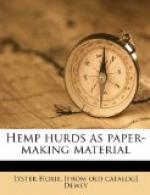=Summary.=
Hemp hurds are the woody inner portion of the hemp stalk, broken into pieces in removing the fiber.
They are not used at present for any purpose that would compete with their use for paper.
Hurds are available only from machine-broken hemp, for the cost of collecting them from the hand brakes would be too great.
About 7,000 tons are now available in restricted localities in Ohio, Indiana, Wisconsin, and California.
The quantity is likely to increase as the use of machine brakes increases.
The hurds may be baled in hemp-fiber presses, with partial burlap covers like those on cotton bales, or possibly chip-board covers.
It is estimated that the farmers may deliver the bales on board cars profitably at $4 to $6 per ton.
THE MANUFACTURE OF PAPER FROM HEMP HURDS.
By Jason L. Merrill, Paper-Plant Chemist, Paper-Plant Investigations.
=Introduction.=
The purpose of this paper is to report upon preliminary tests which were conducted to determine the paper-making value of hemp hurds, a crop waste of the hemp-fiber industry.
The search for plant materials capable of being utilized in paper manufacture is a comparatively recent but world-wide activity which has for its object the husbanding of present sources of paper-stock supply by the substitution of new materials for some of those which are rapidly becoming less plentiful and more costly.
The abstract idea of utilizing that which is at present a waste can play no important role in such activities, the successful commercial outcome of which must be based on the three fundamental factors—market or demand for product, satisfactory raw material, and cost.
Since hemp hurds are to be treated in this report as a raw material for the manufacture of book and printing papers, the qualities, supply, probable future, and cost of the material will be considered in comparison with wood, with which it must compete. There seems to be little doubt that the present wood supply can not withstand indefinitely the demands placed upon it, and with increased scarcity economy in the use of wood will become imperative. This effect is already apparent in many wood-using industries, and although the paper industry consumes only about 3 per cent of the total forest cut, it is probable that it will be affected through this economy. Our forests are being cut three times as fast as they grow, and as wood becomes more expensive proper growing and reforesting will receive more attention. Thus, naturally, a balance will be established between production and consumption, but as this condition approaches its limiting values the price of wood may rise to such levels that there will be a demand for other raw materials.
The use of waste paper in conjunction with chemical wood pulp has increased to enormous proportions, and it is probable that the increase will continue. Although it is a cheaper raw material than wood, it is reasonable to suppose that as the wood supply decreases and the price of wood pulp advances, the price of waste paper will advance somewhat proportionately.




